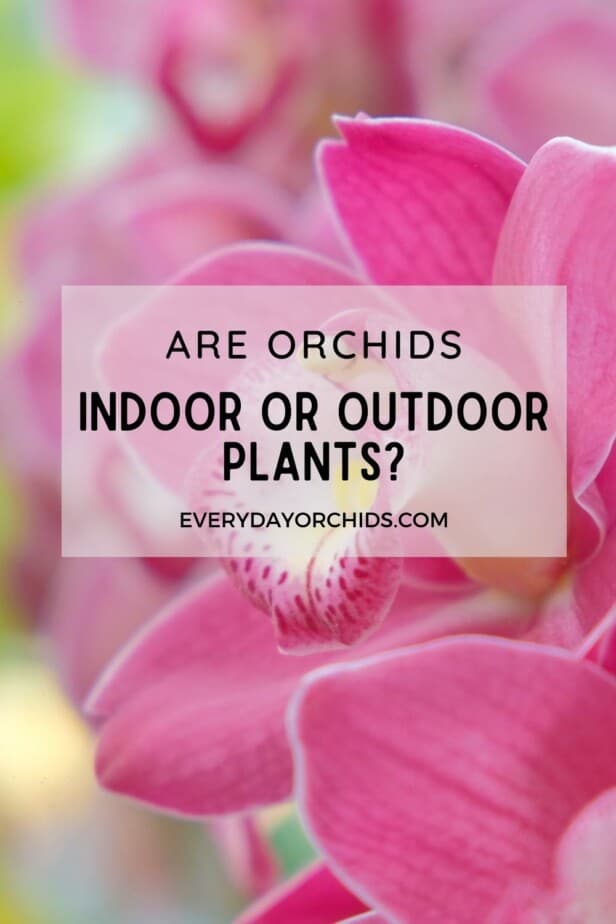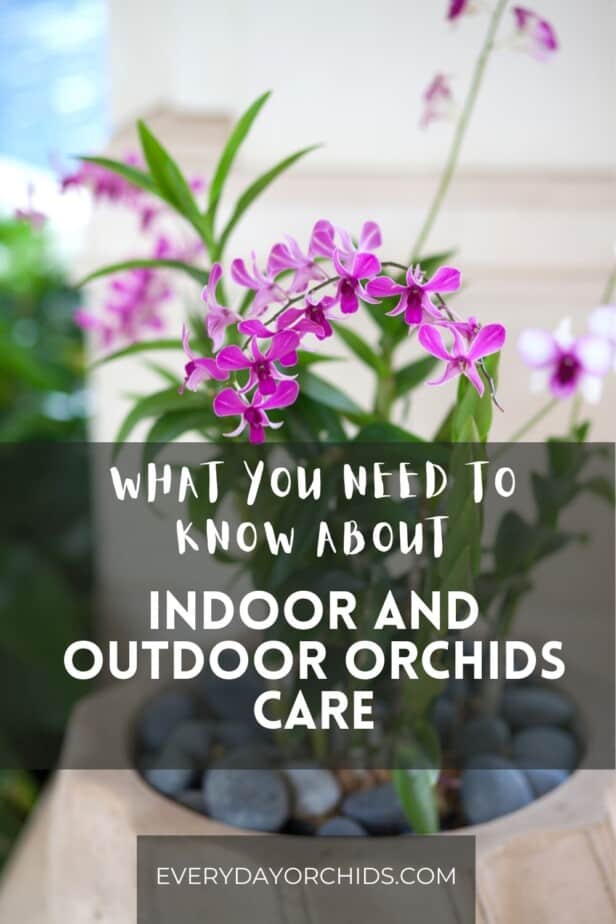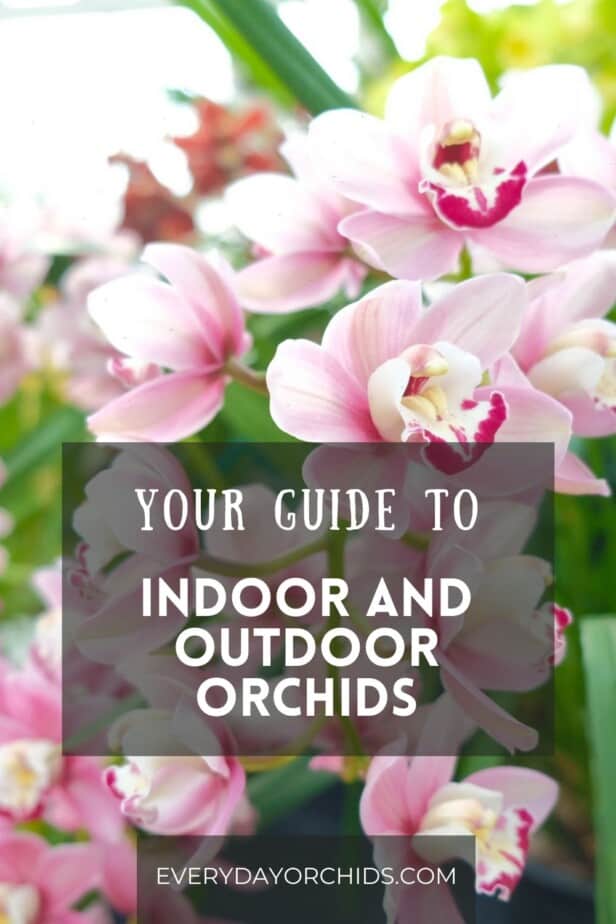Whether you keep your orchids indoors, or care for them outdoors, there are certain nuances to their care that you will need to know. Certain orchid species, such as terrestrial orchids, are well-suited for outdoor living. Other species, such as Phalaneopsis orchids, can only survive outdoors in certain climates and weather conditions. Keep reading to learn more about how to care for orchids indoors, or if you prefer, outdoors.
Orchids can either be indoor or outdoor plants, depending on the species and their temperature tolerance. There are orchid species that love getting full sun, and there are also species that do not. Climate and certain environmental factors, such as temperature and humidity levels in your area, will play a role in whether your orchids will be happier inside or outside the house.
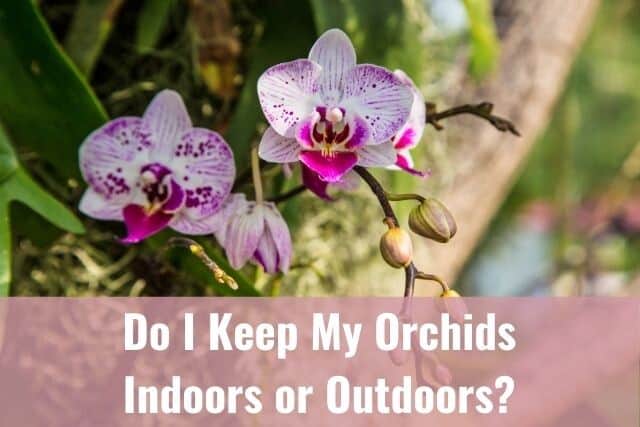
If you are interested in adding orchids to your home and garden, I’ll go over what are the best orchid species to keep indoors and which orchid species are best suited for the outdoors. You’ll also learn about the environmental conditions that would help your orchids thrive wherever you decide to keep them.
Please note that these links are affiliate links and as an Amazon Associate, I earn from qualifying purchases. Purchases made through affiliate links in this post may generate commissions at no additional cost to you. Use this link for a discounted Amazon Prime trial. Thank you for your support!
Table of Contents
Orchids: Are They Indoor or Outdoor Plants?
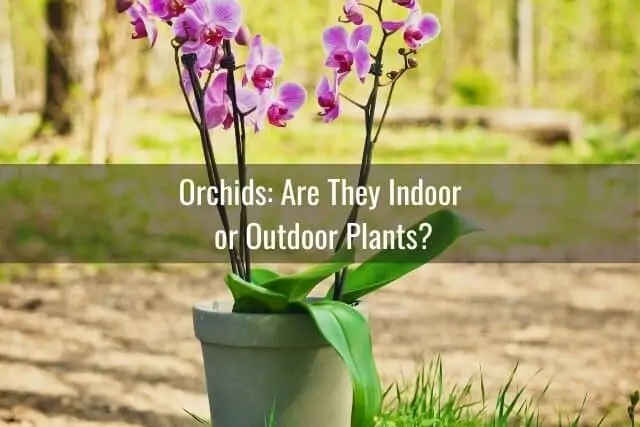
Orchids make such lovely additions to our homes because of their uniquely shaped and colorful blooms. Some growers keep their orchids indoors and display them in fancy pots. Other growers keep their orchids outdoors, where they easily become the stars of the garden when in bloom.
In their natural habitat, orchids in the wild grow outdoors (of course!). Many orchid species are epiphytes, which means they grow on trees and absorb water and nutrients from the air.
A lot of these outdoor orchids thrive under bright light. The canopy of tree leaves protect outdoor orchids from the harsh effects of direct sunlight. Air movement around the orchid plant helps prevent mold growth and root rot.
These lighting and temperature conditions can be easily replicated indoors as well. This allows many outdoor orchids to be cultivated as houseplants. To learn more about how much light orchids need, read more in this guide about orchids and light.
In general, most orchids thrive in subtropical to tropical climates. Taking orchids indoors has become a necessity for many orchid growers. This is especially true for those who live in areas where temperatures drop significantly in the cooler months.
If left outside when the temperature drops, orchids are at risk for cold or frost damage. However, you can control the temperatures inside your home, making it possible to grow orchids indoors. Keeping your orchids indoors can help you meet your orchid’s specific temperature tolerance and growth needs despite poor outdoor weather.
As such, orchids can be indoor plants or outdoor plants, depending on the species’ specific conditions for lighting and temperature. Whether or not your orchid can survive outdoors year-round really depends on where you live.
If you are interested in learning more, read this guide on how to care for orchids outdoors. That guide also lists the temperature tolerance ranges for some popular orchid species to help you decide whether or not your orchid can survive outdoors. Many orchids can be grown indoors or outdoors as long as they have the right growing environment.
What Makes Orchids Good Indoor Plants
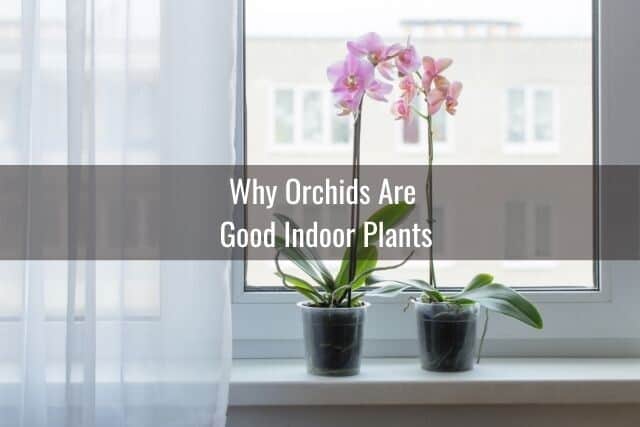
Orchids make good indoor plants. They beautify and brighten up your home when they are in bloom. They can also help improve the air quality inside your home. This is because plants absorb the carbon dioxide that we breathe out and in turn, release oxygen.
Another reason why orchids are great indoor plants is that they do not require potting soil. Instead, orchids use a special type of potting media specific to orchids such as this orchid potting media by Perfect Plants.
Orchid potting media contains bark, charcoal, perlite and other components. One of the benefits of growing orchids is that because of this unique potting media, you don’t have to worry about dirt getting inside your house.
The absence of dirt is also an advantage if you have pets. Cats and dogs are often fond of digging in and playing with soil. Orchids potting media is less tempting for pets and even children to dig through.
Orchids also have a relatively small root system that does not require huge planters. Most orchids are housed in 4 to 6 inch sized pots. This pot size can easily be accommodated on window sills, coffee tables, and dining tables. Orchid pots do not occupy too much space, making these plants ideal for apartment dwellers.
Moreover, orchids add a beautiful touch of green to your home. They can even be used to enhance a home’s feng shui.
When they are in bloom, orchid flowers provide an even lovelier pop of colors. This is especially true if you have minimalist decor or if your interior aesthetics lean towards neutral colors like black, white, and grey. In fact, you can use specific orchid colors to boost your home’s feng shui.
Some cultures, like the Chinese, also believe that orchid blooms are therapeutic and have medicinal properties. If you are into traditional or alternative medicine and know how to use these orchids, you might like to keep these plants handy.
Orchid Species That Make Ideal Indoor Plants
The best indoor orchid species include the Phalaenopsis or moth orchids, Cattleyas, Dendrobiums, and the Cymbidium or boat orchids. These orchids enjoy bright light but dislike direct sunlight. They thrive in more controlled temperatures similar to the ones you enjoy inside your home. They do not require frequent watering. Most even prefer to get nearly dry before the next round of watering.
Some common examples of indoor orchids include:
Phalaenopsis or Moth Orchids
Moth orchids produce flowers that look like moths, hence the nickname. These blooms tend to last for months. Blooms of different varieties come in various colors and sizes.
These orchids can thrive indoors. Just place them in a location with bright, indirect light and shield them from the direct afternoon sun. An east-facing window where they can be exposed to the morning light would be ideal. They will be fine with west- or south-facing windows, too. However, you will need to use curtains such as these sheer linen curtains to help filter the direct afternoon sunlight from these windows.
Phalaenopsis orchids also do not require frequent watering. You can water these orchids once or twice a week in the summer months using lukewarm water. Water just once every two weeks during the winter.
What’s more, these orchids love the same temperatures we do. Keep in mind though that temperatures near the window can be much hotter or colder than the rest of the house. You will have to pay attention to how your plant tolerating its location near the window.
For more information, here is a guide to Phalaneopsis orchid care.
Cattleya Orchids
Cattleya orchids come in a wide variety of forms and colors, thanks to hybridization. Some Cattleya blooms also have streaks, freckles, and bicolor features. These gorgeous blooms can last one to four weeks. Flowering usually takes place between winter and spring.
These orchids love bright indoor lighting. If you decide to keep your Cattleyas outdoors, they prefer to placed in the shade. However, they still need to be exposed to bright light. You can play around with where you put your Cattleya and see if the location gets enough light.
Medium green leaves indicate that the orchids are receiving the proper amount of light and are healthy. If the leaves turn dark green, this can be an indicator that the orchid is not receiving enough light. Meanwhile, too much sun would give their leaves a reddish hue. Orchid leaf color can tell you a lot about whether or not they are getting enough light.
You also need to allow your Cattleyas’ potting media to dry out completely before giving them the next round of watering.
Dendrobium Orchids
Dendrobium is a large orchid genus with over a thousand species. The most common Dendrobiums have lavender, white, or yellow flowers. Their blooms are top-heavy, so they often require a stake. Dendrobiums usually are grown as houseplants.
They love bright, diffused light inside the house. If you grow them outdoors, keep them in a partly shaded section of your garden.
Cymbidium Orchid or Boat Orchids
Cymbidium orchids have small blooms, but they can grow multiple flower spikes with at least a dozen blooms per spike. As a result, Cymbidium orchids create an abundant and beautiful display when in bloom. Their long and thin leaves add to their elegant look. These blooms can last one to three months.
Cymbidium orchids are usually grown as indoor plants. They also love diffused light inside the house. In addition, Cymbidium orchids are more tolerant to cold temperatures compared to many other orchid species.
Allow the orchids to dry out completely before the next watering. You can water them more frequently during their growing season. This is usually in the spring and summer months.
I go into more depth about Cymbidium orchids here, so please check that out if you want to learn more about how to care for your Cymbidium orchid.
Why Orchids Are Good Outdoor Plants
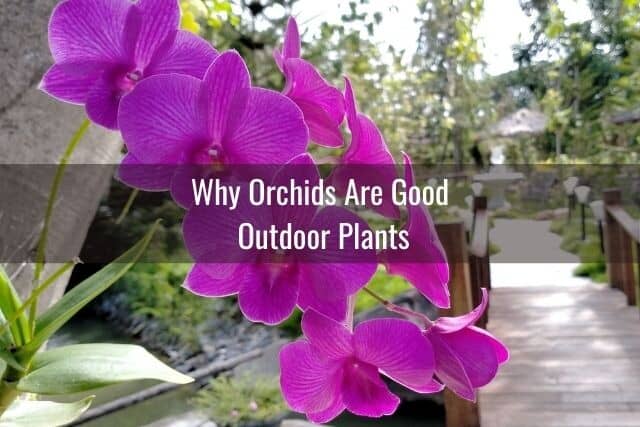
Some orchids make good outdoor plants because they grow well in the company of trees and other plants. You can hang them on tree branches or mount them on tree trunks. Place your orchids under the shade of the trees, and they will fit beautifully right into your garden.
In fact, epiphyte orchids normally grow on trees when they are in their natural environment. Outdoor orchids would do well in areas of your garden that get a fair amount of indirect sunlight and shade.
An example would be an area of your garden that is under a canopy of trees. Once these orchids bloom, they will add a dash of exotic colors to your garden amidst a sea of greens.
Just remember that orchids need bright, indirect sunlight. Direct sunlight, especially during the afternoons, will burn the orchid leaves. You can invest in a sunshade or canopy such as this one to protect your orchids.
Keep in mind that not all orchids are epiphytes. Terrestrial orchids need to be planted in pots or the ground. You can plant terrestrial orchids in flower beds or in a well-draining area of your garden.
Before you mount your orchid onto a tree, make sure that particular orchid species is suitable for outdoor living. You will also need to know whether it is an epiphyte or terrestrial orchid.
Orchid Species That Make Ideal Outdoor Plants
The species of orchids that grow best outside the house are terrestrial orchids. Vanda orchids can also thrive outdoors mounted onto trees. These are typically the orchids whose root systems get too long and dense to contain in a pot.
Most outdoor orchids need lots of light but still prefer a fair amount of shade, especially in the afternoons. Surround these orchids with taller plants and trees whose leaves will filter sunlight for them. There are also species of orchids that can tolerate exposure to full sun and are temperature-tolerant.
Outdoor orchids also require good air circulation around the roots and would prefer a wide-open area of your garden. In terms of water, the ideal outdoor orchids do not require daily watering and do not need excessive moisture.
Most of the ideal indoor orchids mentioned above would do well outdoors. You just need to provide them with their required growing conditions.
Examples of good outdoor orchid species or varieties include Epidendrum orchids, Encyclia species and hybrids, Spathoglottis, and Vanda orchids.
Epidendrum Orchids
Epidendrum orchids thrive in sub-tropical to tropical climates. If you live in a generally warm place, then this orchid will be happy to stay outdoors. Otherwise, they can also thrive in warm interior conditions.
These orchids are tough and are used to inhospitable conditions, but they cannot survive freezing temperatures. You will need to bring them indoors once temperatures start to drop below 50 degrees Fahrenheit (10 degrees Celsius).
Epidendrums need minimal care. They love bright, indirect light. Plant them in a pot with low-nutrient media.
Encyclia Species and Hybrids
Encyclia or cockleshell orchids grow best when mounted on trees or on orchid mounts. This simulates their natural environment’s epiphyte conditions. The leaves of these orchids look like Cattleyas. However their blooms look like an octopus because of their drooping petals and sepals. Encyclia orchids can flower for several months at a time.
These orchids need plenty of filtered light, especially morning sunlight. They will grow well in partially shaded areas of your garden. The shade will protect them from the hot afternoon sun. Too much direct light will cause burns on their leaves.
Encyclia are temperature-tolerant, although their temperature preferences are diverse, depending on their species. Some species are happy with cool temperatures. Other species prefer a range of 50 to 85 degrees Fahrenheit (10 to 29 degrees Celsius).
Spathoglottis
Spathoglottis orchids are terrestrial or ground orchids that can be planted in flower beds. If you live in warm regions, such as central or south Florida, these plants can stay in the ground year round. They produce tall flower spikes and can bloom continuously.
However, for areas that experience cold seasons, Spathoglottis should be planted in pots. This way, you can bring them indoors once temperatures start to drop, especially during the fall or winter.
These orchids are very forgiving and can tolerate full sunlight and partial shade. As long as the temperature is not above 80 degrees Fahrenheit (27 degrees Celsius) during the day and not below 50 degrees Fahrenheit (10 degrees Celsius) at night, they will be happy.
Spathoglottis love moisture, but, like many orchids, they do not like their roots sitting in water. You will need to plant these orchids in well-draining soil. Water them thoroughly around twice a week or when the topmost layer of the soil has dried out.
Vanda Orchids
Vanda orchids are mostly warm-loving and full-sun-growing types of orchids. These plants originated in tropical Asia so that they would thrive outdoors in warm climates. In places where winters can get cold and temperatures drop to freezing, these orchids need to be brought indoors. They can be brought back outdoors during warmer weather (summer).
Terete types are Vanda orchids with round and pencil-shaped leaves. These require full sun and would grow best in high-light climates. For the rest of the Vandas, bright, indirect light is adequate for their needs.
For most Vandas, the optimum temperatures are 60 to 70 degrees Fahrenheit (16 to 21 degrees Celsius) at night. During the day, they can tolerate up to 95 degrees Fahrenheit (35 degrees Fahrenheit). These orchids may need to be watered daily if it is warm and sunny. But when it is cold, you can water them sparingly. Always check the condition of the potting media and see how wet or dry it is before you water.
Vandas tend to have an extensive root system. They are mostly grown in wooden baskets with slats or containers with coarse potting medium. They also do well on orchid mounts.
What Weather Conditions Are Good for Outdoor Orchids?
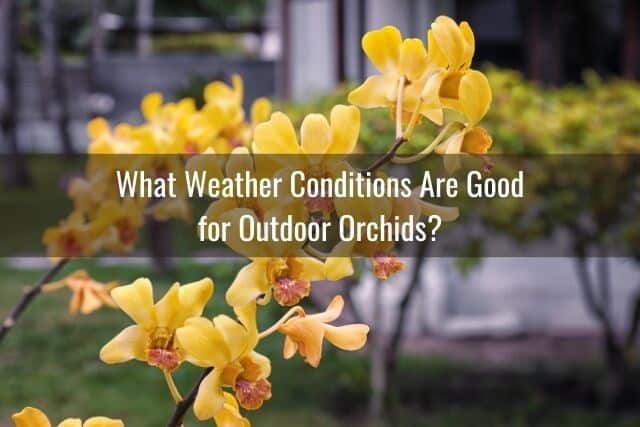
Warm and sunny weather is ideal for most kinds of orchids. That is because most of them are subtropical or subtropical plants by origin. They love getting lots of morning or filtered light but dislike exposure to direct sun. As such, they love locations with partial shade.
They also love a little moisture and a high-humidity environment. So whether the orchids are outdoors or indoors, regular misting would help. This is especially true if you live in a dry environment. You can also increase humidity by setting your orchids’ pots atop humidity trays filled with gravel and a little bit of water.
When to Move Outdoor Orchids Inside
If you live in a location that experiences freezing winters, you will need to move your outdoor orchids inside once it starts to get cold. Many orchid growers do this as part of their fall orchid care. That means your orchids will get to spend their time outdoors only during the spring and summer.
Indoors, you will have control over the temperature, thanks to your thermostat or heating system. Orchids may find the change in environment stressful, so you will have to allow them to adjust and acclimate slowly.
To do this, you may want to move your outdoor orchids to your porch and leave them there for a few days. Gradually move them indoors for a few hours at a time. Continue this process until the orchids get used to being indoors for the entire day.
Different orchid species have different levels of tolerance when it comes to a specific temperature range. It is important to know what your particular type of orchid can handle. You may also get confused when searching for the ideal temperature range for certain species. This is because different sources may indicate different temperature ranges.
You can check your plants for signs of stress by looking at the leaves and their color. This would help you know if your orchid is tolerating its environment or not.
For example, dark leaves mean the orchid is not receiving enough light indoors. Uneven and yellowish leaves means that the orchid has been exposed to too much light. Orchids that are getting just the right amount of light have light-green to medium-green leaves.
Plants that are experiencing slow growth have shorter spikes and fewer flowers than usual or are downright refusing to bloom. Not reblooming could also mean the orchids are not receiving the right amount of light.
Final Thoughts
Orchids are outdoor plants by nature, but they can also thrive indoors. They generally prefer warm temperatures with bright, indirect sunlight, which we can recreate in our homes. In fact, in places where winters get very cold, taking orchids inside when temperatures drop is a necessity. Whether your orchids should be placed outdoors or indoors depends largely on where you live and your particular orchid species.
Regardless of where you keep your orchids, the most important thing to know is your orchid’s specific growing requirements. Do your best to learn more about the orchids you are growing. As you learn about the species, you will be able to provide it with the growing conditions and location where it will be most happy and healthy.
If you enjoyed this article, please pin it and share!
